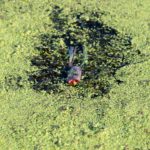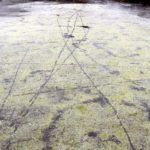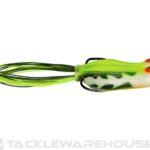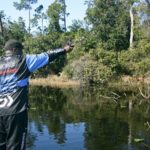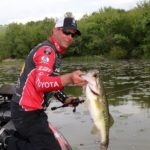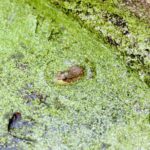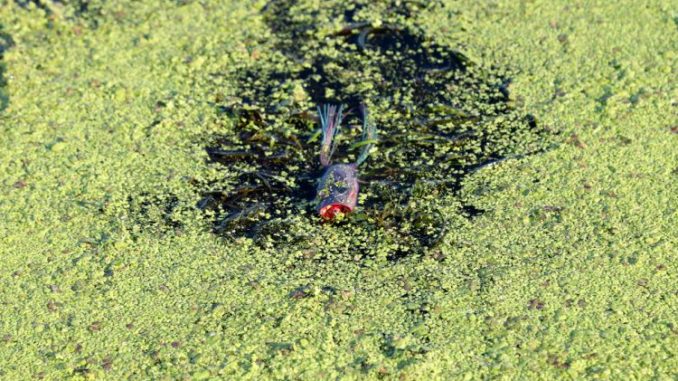
Working hollow-bodied frogs like the best
You’d almost think this thing was a CIA operative, what with all the different identities, abilities and serious armament. At the risk of stretching a not-so-subtle Jason Bourne reference too far, let’s just say that the topwater frog is one deadly asset for just about anytime but the depths of winter and whenever fish hug deep structure. So proficient is the frog’s fish-tempting allure that this floating amphibian impostor is a go-to bait for tournament pros and guides who depend on it for a wide range of applications.
Bassmaster Elite Series pro and accomplished frogger Ish Monroe designed his signature Snagproof Ish’s Phat Frog for convincing impersonations; but he’s quick to tell you a frog’s splashing, popping and waking displays can also resemble shad flickering, a rat swimming across the surface or a bluegill meandering around a dock or vegetation.
With the exception of a few open-water scenarios, most froggers do their work around cover — either natural or manmade. Bassmaster pro Kevin VanDam knows that spring offers excellent opportunities for bass to target frogs, but the rest of the year, the premise is more straightforward.
“During the spawn through postspawn period a lot of the fish are out in the open and they’ll come right off a bed and eat a frog in a heartbeat because they’re very protective against bluegill,” he said. “And then all the way through that postspawn period where they’re guarding fry, that’s when I fish them in the open.
“The rest of the year, it’s about the overhead cover; it’s about the shade and getting around the targets.”
For this reason and for certain presentation particulars, FLW pro Dennis Tietje of Roanoke fishes his Strike King Sexy Frog on 65-pound Sunline braid. For him, strategic bait placement helps preserve his opportunities.
“The braid allows the frog to float freely and gives you a fast response time to get that fish out of heavy cover,” he explained. “Make a long cast and hit the shoreline then work your frog into the water. This prevents spooking the fish with the bait directly hitting the water.”
Delving deeper into frog strategy, let’s look at some of the other insights that consistently deliver big results for bass pros.
Perfectly placed
Looking at the classic frog scenario — a fishy-looking expanse of matted vegetation — one might feel like a kid-in-a-candy-store. However, Pickwick Lake guide Jimmy Mason advises a disciplined regimen he calls “slicing the pie” — making well-aimed casts to cover the mat without a lot of overlap, but no big gaps. You don’t have to line every inch of the mat, but dividing it into manageable segments ensures efficiency.
That being said, FLW pro Ray Hanselman points out the occasional wisdom of following another’s lead. When he spots an area with multiple blow-up holes, he knows that indicates a school, or at least a group of bass.
Similarly, Hanselman said if a fish blows up and misses, he’ll hit that spot again with great optimism. I saw this firsthand while working a grass bed with Hanselman. Two prominent gaps in the mat’s slimy cover bespoke of recent violence and immediately drew my attention. Lining up my shot, I cast about 30 feet past the nearest hole, walked the frog to within 6 feet of the impact zone.
The last few feet I covered with erratic twitching with several pauses and restarts. Well, this ruse must’ve flipped the switch because the moment my frog breached the small circle of open water, a 3-pounder did its best to knock the paint of the bait.
“There’s always something that attracted that fish to that spot,” he said. “It might be a stump or (some other bottom feature), but if a fish blows up on your frog, but misses, he’ll usually go right back to the spot where he was sitting. So if you make another cast and bring it right across that same spot, he’ll often hit it again.”
Double duty
Walking frogs, or poppers, which one? Well, it really comes down to the area you’re fishing because a walking frog’s narrow nose tends to find its way through heavier vegetation like lily pads, spatterdock, etc., while that noisy popper does a good job of calling distant fish in open water.
Often, you’ll find kind of a hybrid scenario with scattered vegetation interspersed by patches and lanes of open water. Here, VanDam likes the Strike King Popping Perch, a double-hook frog style bait with molded features resembling a panfish and a more pronounced, fin-like tail.
“I like that bait because it walks exceptionally well in open water, but if you want to chug it and really make it push some water, it will create a disturbance to draw those bass up out of the grass,” he said. “It’s also good in the pads because it will slide right over the cover and when I get into the open, I can just walk it back and forth.”
With any popping frog style bait, you’ll face the occasional tug of ensnaring cover as that broader face catches against the habitat. No worries; a sharp upward snap of the rod tip usually frees your frog — especially with braided line.
Strength to conquer
With any topwater frog style, current Bassmaster Classic champion Jordan Lee suggests dropping a little Super Glue, Loctite or other adhesive to a couple of key spots on your frog. First, the belly weight. A couple of drops around the weight keeps this balancing element from popping out during the heat of battle. Also, a shot of glue right behind the hook eye bonds the nose to the hook, keeps the body straight and prevents it from pulling down along the shank.
On the slide
Keep the overhead cast in your playbook, but VanDam suggests learning other ways of delivering a frog.
“The great thing about these hollow body frog baits is they skip really well,” he said. “You want to throw them on braid and I prefer 65 pound because I think it helps the frog skip better than thinner diameter braid. You have fewer problems with backlash (with heavier braid).
“If you have any willows or cypress trees where there’s some shade, you want to skip that frog underneath there.”
Also, Monroe suggests learning to pitch a frog for precision placement, as well as expanded opportunity. Often, shoreline cover will present target diversity accommodating traditional casts and short presentations. Rather than changing your angle/distance, simply alter your presentation style and you’ll maximize what’s in front of you.
In tournaments or fun fishing, the angler in the back of the boat often has limited access to prime targets and by the time he has a clear shot, the boat’s moving away and he’s left with a hurried retrieve that’s long on haste and short on efficiency. Pitching a frog allows the backseater to at least probe a few spots along the way.
New arrivals
When big rains fall, take Hanselman’s advice and put that frog to use whenever lake levels are on the rise. Whether it’s a return to normal after drought conditions or a legitimate flood, advancing water spells opportunity.
The fish that push into these newly accessible areas are bold and hungry — the perfect combination for aggressive feeding. Consider also, that insect and amphibian forage will also get displaced and relocated by rising water, so the bass are expecting to find a lot of creatures jumping around and scampering for cover. Convince them that your topwater frog is one of the tasty morsels they seek.
In closing, VanDam offers this frog plug: “Louisiana and Mississippi are ideal for frogs. From once the bass start spawning in the spring, all the way ’til late in the fall, a frog is something you have to have tied on.”
